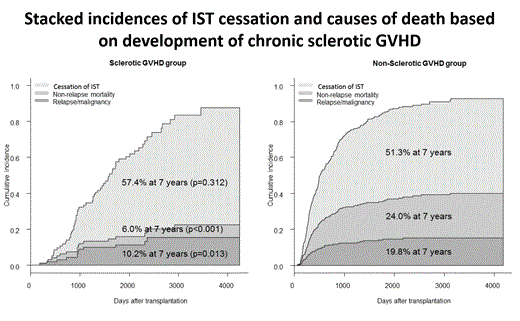Abstract
Chronic graft versus host disease GVHD) is one of the major complications of allogeneic hematopoietic stem cell transplantation (HSCT) and is associated with significant morbidity and poor quality of life. A few studies reported the incidence of sclerotic GVHD to range between 15.5% and 52.9% among patients with chronic GVHD (cGVHD). However, the risk factors and clinical markers associated with sclerotic GVHD (SclGVHD) are yet to be identified which led us to review the incidence of and risk factors for SclGVHD at our institution.
We retrospectively reviewed 756 patients who underwent HSCT between 2000 and 2012 at the Princess Margaret Cancer Centre, Toronto Canada. We identified patients who were diagnosed with cGVHD, re-classified this using the National Institute of Health consensus criteria (NCC) and identified those who developed SclGVHD. We evaluated HSCT outcomes including overall survival (OS), non-relapse mortality (NRM), relapse and duration of immunosuppressive therapy (IST). The Kaplan-Meier method was used for OS and the cumulative incidences of SclGVHD, cGVHD, NRM, relapse and IST cessation were calculated considering completing risks. Univariable and mulrivariable analyses were done using the Gray’s and Fine-Gray methods and EZR software.
Of the 756 patients, 502 had cGVHD by NCC and among these 96 (19.1%) had SclGVHD. The median time to onset of SclGVHD was 540 days (range 481-577). Only 7 (7.3%) patients had SclGVHD as the first manifestation of cGVHD, while the remainig 89 (92.7%) had preceding other organ involvment. The cumulative incidence of SclGVHD was 22.6% at 5 years (95% CI 18.6-26.8).
A univariable model identified 2 risk factors for SclGVHD: T-cell depletion (TCD) (4.0% in TCD vs 25.9% in non-TCD; p<0.001) and peripheral blood stem cells (PBSC) (26.5% in PBSC vs 10.2% in bone marrow, p<0.001). Acute GVHD and mismatched or unrelated donors did not increase the risk of SclGVHD in univariable analysis. Multivariate analysis confirmed that the 2 factors identified in the univariable model were independent risk factors for SclGVHD: TCD (p=0.001; HR 0.14, 95% CI, 0.05-0.46) and PBSC (p=0.001; HR 2.96, 95% CI, 1.52-5.74).
OS at 7 years after HSCT was significantly better in the SclGVHD group (87.5%) than in the non-SclGVHD group (58.4%) (p<0.001). However, once the time-dependent variable of SclGVHD was taken into account, the favorable prognostic impact of SclGVHD on OS became borderline (p=0.06, HR 0.55 [95% CI 0.29-1.04]).
In view of the OS results we attempted to ascertain the clinical course of SclGVHD by evaluating its impact on duration of IST and causes of death in patients who develop it. As shown in Figure 1, those with SclGVHD seem to have a longer IST duration (median 70.5 months) compared to those without SclGVHD (median 62.0 months). However, there was no difference in the rates of IST cessation at 7 years (57.4% vs 51.3%; p=0.312). The SclGVHD group showed a significantly lower NRM rate at 7 years; 6.0% vs 24.0% in the non-SclGVHD group (p<0.001). Similarly, the SclGVHD group showed a lower incidence of relapse at 7 years; 10.2% vs 19.8% in the non-SclGVHD group (p=0.01).
The incidence of SclGVHD at 5 years is significant at 22.6%. Two risk factors for SclGVHD were identified: PBSC and non-TCD. HLA-mismatch was not identified as a risk factor. SclGVHD does not appear to have an adverse effect on OS, NRM or relapse. SclGVHD was associated with longer IST duration but the IST cessation rates at 7 years were similar in the groups with and without SclGVHD.
Stacked incidences IST cessation and causes of death based on the development of chronic sclerotic GVHD

No relevant conflicts of interest to declare.
Author notes
Asterisk with author names denotes non-ASH members.

This feature is available to Subscribers Only
Sign In or Create an Account Close Modal